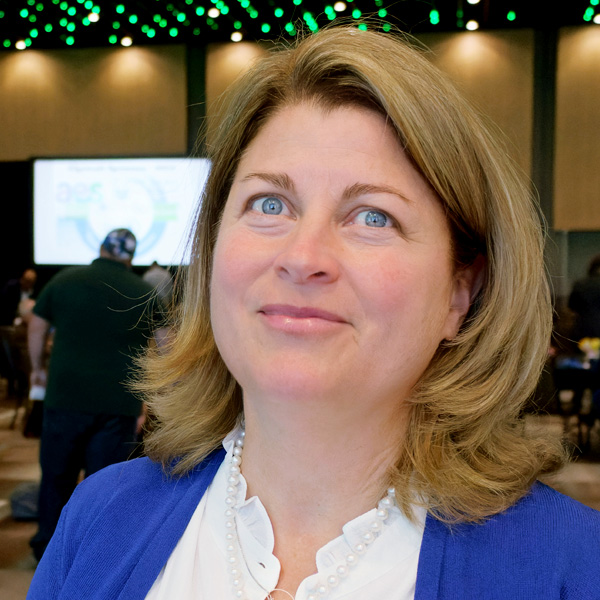NEW ORLEANS — The Joint Federal-State Task Force on Electric Transmission’s fifth meeting since its inception last year featured dialogue on local project review, cost management and FERC’s notice of proposed rulemaking on regional transmission planning, cost allocation and cost containment (AD22-8). (See States Urge More Transparency on Tx Planning, Independent Monitors.)
FERC Chairman Richard Glick opened the task force’s discussion Tuesday during the National Association of Regulatory Utility Commissioners’ annual confab by noting there is a lot of “costly” transmission on the horizon.
“So, we need to make sure that consumers get the best bang for their buck,” he said.
Jason Stanek, chair of the Maryland Public Service Commission, said even if the task force already had managed to achieve consensus on a planning approach and cost allocation methodology, cost management and project review would still be issues.
“What I’ve been hearing is something is lacking, something is missing in this process,” FERC Commissioner Willie Phillips said of transparency in proposing and reviewing local transmission projects.
Phillips said it’s “interesting” that states seem unable to replicate the results of utility planning studies, especially since FERC requires them to do so.
 FERC Chairman Richard Glick (left) and Maryland PSC Chairman Jason Stanek | © RTO Insider LLC
FERC Chairman Richard Glick (left) and Maryland PSC Chairman Jason Stanek | © RTO Insider LLC
Glick said the depth and breadth of regulatory gaps depend on the type of project and whether they’re located in an RTO. But he said a great number of local projects don’t appear to have a “sufficient level of review.”
“It’s not easy to determine whether a decision is right, especially when there’s a lack of transparency in the process,” he said.
Pennsylvania Public Utility Commissioner Gladys Brown Dutrieuille said only projects 101 kV and above that require new siting are subject to intensive review in the state. She said over the last several years, her commission has seen big increases in smaller and rebuild transmission projects that are handled by staff and don’t require a thorough review.
California Public Utilities Commissioner Darcie Houck said that most of PG&E’s billions of dollars in planned projects through 2026 will fall under CAISO’s category of self-approved projects that bypass review.
“We’re seeing the same trends,” Michigan Public Service Chairman Dan Scripps said. He admitted that he isn’t yet sure who should provide project oversight and said it might be some combination of FERC, the states and grid operators. He also said should the federal agency introduce independent transmission monitors, it should take care to make sure it doesn’t slow project development.
Phillips said FERC also must ensure that an independent transmission monitor doesn’t create an incentive for utilities to leave RTOs.
Review Tied to Formula Rates?
FERC Commissioner Mark Christie said some projects are scrutinized at the state level while others get by without oversight. He pointed out that while FERC cannot prescribe projects, it does wield control over formula rates. The commission could condition its formula rate treatment on whether a project has undergone a credible, state-level review, he said.
“And we’ll let the states tell us if it was credible,” suggested Christie, adding that FERC could apply the question to multiple states for interstate lines.
Christie said the national transmission rate base has increased 9% or more for the third year in a row.
“What goes into rate base goes into customers’ bills — every nickel,” he said.
Stanek said he didn’t think states, which are “perpetually” underfunded and understaffed, should be tasked with undertaking project prudency studies on the bulk power system. He said such analyses would be too complex and expensive.
“I think Commissioner Christie is on the money that formula rates are an incentive. They’re a carrot,” said Matthew Nelson, chair of the Massachusetts Public Utilities Commission. He said he supported the idea of “step-down” return on investments, where cost overruns would trigger reduced rates.
FERC Commissioner Allison Clements said the task force might consider creating a standardized data collection from transmission developers across all 50 states. She asked what happens if FERC discovers a state doesn’t have a credible project review process.
Christie suggested commissions call on expert RTO witnesses to testify on the prudency of some proposed projects. He reminded regulators that utilities bear the burden of demonstrating that a project is necessary before state commissions.
Kansas Corporation Commissioner Andrew French said establishing independent transmission monitors would be most helpful for local projects. He said large projects subject to regional cost sharing already are sufficiently inspected by parties that stand to pay.
French said at present, transmission owners can easily finalize local and replacement projects that maintain a status quo system.
“There just isn’t an incentive to [propose] an optimal solution,” he said, adding that commission staffs need help understanding the pace of investment and whether transmission owners are engaging in optimal planning.
However, Georgia Public Service Commissioner Tricia Pridemore, who replaced former Arkansas regulator Ted Thomas on the task force, denounced a “top-down” level of review. She said Georgia has a solid planning process that invites economic development, and it has never experienced a major blackout.
Glick countered that there has been a “ballooning” of local projects and some attention on them would be worthwhile.
“It might be that non-RTO states have sufficient authority,” he said.
Glick wrapped the meeting by urging the task force to keep up the collaboration if he doesn’t return to the task force for its next meeting in February. (See Glick’s FERC Tenure in Peril as Manchin Balks at Renomination Hearing.)
Clements Weighs in on Planning Direction
In a Monday keynote during the NARUC meeting, Clements urged thoughtful, low-regret transmission planning so customers don’t experience “wild jumps” in the transmission component of their bills.
Clements said FERC commissioners could issue hundreds of pages of cost-management decrees and “sit very smugly,” but if states and utilities don’t think the resulting cost containment rules are fair, they will be pointless.
She said the commission is laying crucial groundwork to get new infrastructure built: “To me it’s not so much as an ambitious agenda as it is an imperative need.”
 FERC Commissioner Allison Clements | © RTO Insider LLC
FERC Commissioner Allison Clements | © RTO Insider LLCClements repeated the industry adage that the transmission system is on the cusp of a buildout like that of the nation’s highway system in the mid-1950s. She said the key to mitigating widespread extreme weather events is to have an interconnected transmission system greater than the size of the weather patterns.
She pointed out that interconnection queues are brimming with projects waiting for grid treatment.
“Right now, we’re looking at twice as much generation than exists on the transmission system today trying to get on,” Clements said.
She said federal and state regulators should help utilities ensure the most efficient use of the existing system through dynamic line ratings and other grid-enhancing technologies,
“Now is the time to do it, since we’re thinking about larger investments in backbone transmission,” she said.
However, Clements said she understands grid operators’ hesitation to introduce system stressors with new transmission technologies. She said control room operators are understandably cautious and protective of system reliability and that FERC is trying to land on “the least scary way” to introduce new technologies.
“If the speed limit is 60, and it’s a nice day in April, maybe go 75,” Clement said. “But if it’s February and icy, go 40. Make the system better and smarter, and I think that’s a great analogy.”
State Rights of First Refusal and Order 1000
A Tuesday NARUC panel deliberated on which is worse: FERC’s failed attempt at competition under Order 1000 or the ensuing wave of state rights of first refusals for incumbent utilities.
Former FERC commissioner Tony Clark, now an adviser with Wilkinson Barker Knauer, said some prefer continued transmission development under monopolies rather than a “complex bidding process that doesn’t work” under Order 1000.
“The state ROFRs are the symptom, but Order 1000 is the disease,” Clark said. “I think we ought to admit that this is an industry that naturally trends toward a natural monopoly.”
Devin Hartman, R Street Institute’s director of energy and environment, said consumers could potentially save several billion dollars with competitive solicitations. He said consumer groups and grassroots movements are organizing to fight state ROFR laws.
Hartman said there’s “no economic reason” to reinstall a federal ROFR.
Ten states have enacted ROFRs: Indiana, Iowa, Michigan, Minnesota, Montana, Nebraska, North Dakota, Oklahoma, South Dakota and Texas.
Four other states have considered such laws: Colorado, Kansas, New Mexico and Wisconsin.
A consumer collective has filed a joint complaint at FERC against MISO’s practice of respecting state ROFR laws in its regional transmission planning and cost allocation (EL22-78). (See Consumer Groups File FERC Complaint Against MISO.)
Wisconsin Public Service Commissioner Ellen Nowak, whose state discussed a bill that ultimately didn’t pass, said viewing the issue as a debate between competition and full regulation is a “false choice.”
“It hasn’t played out as we have expected,” Nowak said of competitive processes in practice. “The sticker price looked good, but then there’s a lot of little exemptions that have to play out.”
“States want control over who is building critical infrastructure in their state… It’s not putting up another Dunkin’ Donuts; it’s critical infrastructure,” Nowak said, explaining that states need trusted utilities. She said incumbent utilities are still beholden to a transparent process, and they can be subjected to cost caps.
However, Nowak predicted that the bill will again be introduced during Wisconsin’s next legislative session.
“ROFRs are anti-competition laws,” said Ari Peskoe, director of Harvard Law School’s Electricity Law Initiative. “This is benefitting the largest incumbents. I’m not sure who else benefits from this.”









